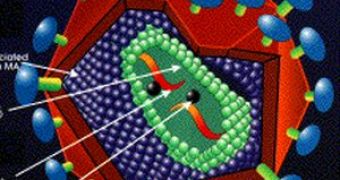Switching off the deadly virus is the dream of many research teams.
After entering a cell, a virus often turns dormant (inactive), inactivating its genes and laying low until something in the environment triggers its action.
In that moment, it starts producing proteins at a rampant speed.
But "noises" in the environment could produce errors in protein transcription and this could pose a problem to the virus. Some bacterial viruses have intricate repressor circuits that block transcription but animal viruses (including HIV) lack them.
A new study proposed for some animal viruses, including HIV, manage this by successively introducing and dissipating a resistor into the main activator of transcription.
HIV's transcriptional activator, responsible ultimately to viral replication, is the Tat gene.
Typical molecular switches on/off of this gene are made by self-oligomerization (binding to several other identical molecules).
Oligomerization leads to two different stable conformations.
But oligomerization does not apply to Tat; instead, both on and off forms appear to be monomers.
HIV Tat transactivates its own expression, but through conversion from deacetylated Tat (TatD) to acetylated Tat (TatA), that shuts off the system.
Thus, acetylation and deacetylation make a resistor in the Tat circuit, explaining the stability of HIV's latent state.
In the Tat resistor model, Tat deacetylation occurs at a much faster rate than acetylation.
Deacetylated (inactive) Tat can take one of two paths-reconversion into acetylated (active) Tat, or destruction of the protein by cellular machinery.
This prediction of the model was then precisely replicated in cell culture experiments.
Further experiments prove it: inhibition of the deacetylating enzyme SirT1 induced Tat transcription activation in cells, further supporting the role of Tat acetylation in controlling viral dormancy.
Finally, simulations under noisy conditions predicted that this simple resistor system was better able to resist environmental fluctuations than hypothetical oligomer-dependent switches, and cell-sorting experiments confirmed this prediction.
These findings explain some mysterious observations about Tat and HIV.
Tat contains at least two acetylation sites that must both be deacetylated to turn off transcription, perhaps to avoid making the off state so easy to reach that the virus remains dormant all the time.
This also explains why some HIV patients experience short "blips" of viral activity, despite relatively low viral concentration.
These pulses of viral activation may be the result of random increases of Tat activity or to environmental inhibitors of the SirT1 enzyme, such as dihydrocoumarin, a natural flavoring agent encountered in clover.

 14 DAY TRIAL //
14 DAY TRIAL //